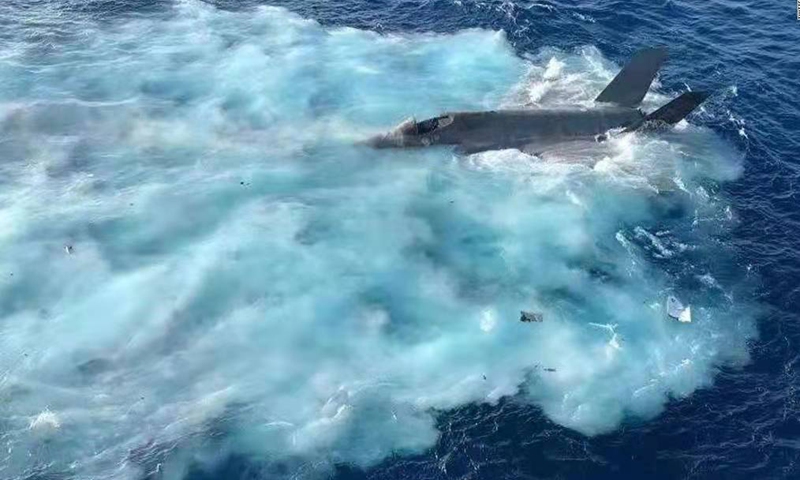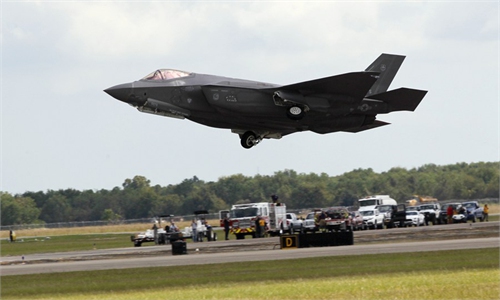US navy confirms authenticity of images showing fighter jet crash, reflecting loose management

Photo:Web
The crash of a US F-35C stealth fighter jet in the South China Sea continues to be a much-discussed topic in Chinese social media platforms, after the US navy confirmed the authenticity of footage and photographs of the accident. Netizens and experts said it indicates technical and operational problems, as well as loose management and exhaustion in the US military, despite the country's desire to flaunt its military might against China.
On Monday, the day after a US dual aircraft carrier group entered the South China Sea, an F-35C stealth fighter jet crashed and then fell into the sea after trying to land on the USS Carl Vinson, one of the carriers.
It is the first known crash of F-35C, one of most advanced stealth fighter jets in the world and each one is reportedly worth $100 million.
A still photograph and a 14-second video about the accident circulated in the global media on Friday. The photograph shows the plane floating on the surface of the South China Sea, its cockpit open after the pilot had ejected. The F-35 can also be seen on its landing approach to the aircraft carrier but the footage cuts off before the plane hits the flight deck.
A spokesperson for the US Navy's 7th Fleet said Friday that an investigation into the incident is ongoing and the images that have emerged on social media since the crash are genuine, CNN reported.
"The ship has assessed that the video and photo covered by the media today were taken on board USS Carl Vinson ... during the crash," Commander Hayley Sims, public affairs officer for the 7th Fleet, was quoted as saying by CNN.
The footage is short, but it shows that the aircraft is very close to the aircraft carrier after finishing the last turn, which leaves little time for the pilot to adjust flying position, Wang Yanan, chief editor of Beijing-based Aerospace Knowledge magazine, told the Global Times on Saturday.
Such a landing method is rare in normal training, and is more likely to be applied during combat or when something goes wrong with the aircraft, according to experts.
"Maybe the pilot was trying to show off, but messed it up… no zuo no die, why you try," a user of China's Twitter-like Sina Weibo commented on Saturday.
"No zuo no die" is a Chinese internet meme that means "one would not be in trouble had one not asked for it."
"Maybe it is just the US navy testing a new amphibious fighter in the South China Sea," another netizen commented.
Some netizens wondered how such a confidential matter could have been leaked and circulated in the global media, as it is an embarrassment for the US navy.
Others said the accident might be a conspiracy by the US military so that they can stay in the South China Sea for longer and even explore the topography in the area.
The operation to recover the F-35C from the bottom of the South China Sea could take up to 120 days, media reports said, citing US military officials.
Experts reached by the Global Times said the US would not have wanted to put itself in such an embarrassing position, especially while trying to flex its muscles on the doorstep of China. The leak of the footage of the crash also shows loose management in the US navy, they noted.
Some explanations for the accident have been suggested. First, the landing speed was too high which meant that the landing gear broke; second, the landing was not in the correct position. Only one of the plane's wheels touched the deck so that the F-35C tilted and fell off the ship, Fu Qianshao, a Chinese military aviation expert, told the Global Times on Saturday.
It might have been because the aircraft carrier was shaking, or the aircraft just targeted the wrong landing site, according to Fu.
More details will be needed to figure out the real cause of the accident. But the fact that the aircraft could be seen floating for a while shows that it smacked onto the surface of the sea rather than heading down directly, Fu said.
However, Wang Yanan noted that the US military will probably not release more details of the investigation as it would involve a lot of confidential information concerning the US navy's combat capacity, such as the training level of their pilots, the management level on the US aircraft carriers and some technical details.
It is also possible that the flight engaged the arresting cable but it then got unhooked. In this case, the cable would kick back and hurt the ground staff, Wang said.
Such an accident would mean that the deck of the aircraft carrier would temporarily lose its work capacity. If this happened during combat, the carrier would be a vulnerable target, Wang noted.
"No matter what the reason is, the accident shows that the US military has some problems with training," a military expert told the Global Times on condition of anonymity, echoing Wang.
The expert also noted that the pilot was probably not concentrating enough when trying to land on the deck so that he failed to correct course in time. The US has carried out numerous exercises in waters near China, so this accident will put a lot of psychological pressure on the pilots and reduce their operational efficiency, the expert noted.


